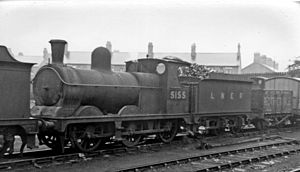
The steam locomotives of British Railways were used by British Railways over the period 1948–1968. The vast majority of these were inherited from its four constituent companies, the "Big Four".
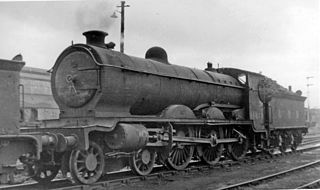
The Caledonian Railway 60 Class were 4-6-0 passenger engines designed by William Pickersgill and introduced in 1916. Six were built by the Caledonian Railway at its own St. Rollox works in 1916–17, and all of them passed into LMS ownership in 1923. A further twenty locomotives of a slightly modified design were built by the LMS under the auspices of George Hughes in the period of 1925–1926.

The Great Central Railway (GCR) Class 8K 2-8-0 is a class of steam locomotive designed for heavy freight. Introduced in 1911, and designed by John G. Robinson, 126 were built for the GCR prior to the First World War. Including wartime construction for the British Army ROD and the post-war GCR Class 8M, the class and its derivatives totalled 666 locomotives.
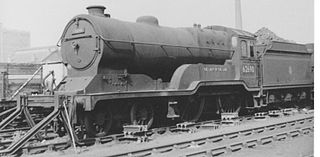
The Great Central Railway Class 11F or Improved Director Class is a class of 4-4-0 steam locomotive designed by John G. Robinson for passenger work. The LNER classified them as Class D11 from 1923. They were based on the earlier GCR Class 11E "Director" class.

The Caledonian Railway 72 Class was a class of 4-4-0 steam locomotives introduced by William Pickersgill for the Caledonian Railway (CR) in 1920. Thirty-two locomotives were built and all survived to be taken over by the London, Midland and Scottish Railway (LMS) in 1923 and by British Railways (BR) in 1948. The earlier 113 Class, of which 16 were produced, were similar but slightly smaller. These were the Caledonian's last express passenger locomotives, and technically, the last of the Dunalastair series, and were unofficially dubbed, Dunalastair V.

The Great Central Railway (GCR) Class 9F was a class of 0-6-2T steam locomotive built between 1891 and 1901. From 1923 the locomotives were redesignated Class N5.

The London and North Eastern Railway Class U1 was a solitary 2-8-0+0-8-2 Garratt locomotive designed for banking coal trains over the Worsborough Bank, a steeply graded line in South Yorkshire and part of the Woodhead Route. It was both the longest and the most powerful steam locomotive ever to run in Britain. It was built in 1925 with the motion at each end being based on an existing 2-8-0 design. The original number was 2395, and it was renumbered 9999 in March 1946, and then 69999 after nationalisation in 1948, although it retained its cab-side plate bearing its original number throughout its life. The locomotive ran for some time as an oil burner, and was tried out on the Lickey Incline in 1949–1950 and again, after the electrification of its home line, in 1955. These trials were unsuccessful, and so the locomotive was withdrawn in 1955 and scrapped.

The Mid-Cheshire line is a railway line in the north-west of England that runs from Chester to Edgeley Junction, Stockport; it connects Chester with Manchester Piccadilly, via Knutsford. After Chester Northgate closed in 1969, the section between Mickle Trafford Junction and Chester was used for freight trains only until it closed in 1992; from Mickle Trafford, passenger trains use the Chester–Warrington line to Chester General instead. The route taken by passenger trains has changed over the years and now differs considerably from the original. Between 2001 and 2014, passenger journeys on the line increased to over 1.7 million per year. A near doubling of the passenger service was expected to occur from December 2018, however this did not materialise.

The Lancashire and Yorkshire Railway Class 28 was a class of 0-6-0 steam locomotive, designed by George Hughes for the Lancashire and Yorkshire Railway (L&YR). It was a rebuild of Aspinall's Class 27, with the addition of a Belpaire firebox and the extension of the footplate and front sandboxes. It was similar, but had larger cylinders and a superheater. It had 5-foot-1-inch (1.549 m) wheels.
The Winsford and Over branch line was a railway line serving the town of Winsford in Cheshire. It was operated by the Cheshire Lines Committee (CLC) from 1870 until the railways were nationalised under the Transport Act 1947, which took effect on 1 January 1948. Thereafter the branch was operated by British Railways London Midland Region until the line's closure in 1967.
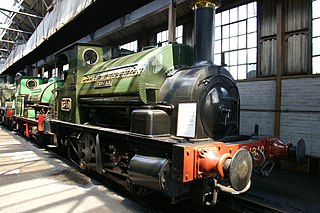
The GWR 0-4-0ST steam locomotives were acquired by the Great Western Railway at the 1923 grouping. They came from small railways and from contractors. Some of them survived into British Railways ownership in 1948 and a few are preserved.

Gorton Locomotive Works, known locally as Gorton Tank, was in West Gorton in Manchester, England and was completed in 1848 by the Sheffield, Ashton-under-Lyne and Manchester Railway.

The H&BR Class G3 was a class of 0-6-0T steam locomotives of the Hull and Barnsley Railway (H&BR). The H&BR became part of the North Eastern Railway (NER) in 1922 and the NER became part of the London and North Eastern Railway (LNER) in 1923.

The GCR Class 5 was a class of twelve 0-6-0ST steam tank locomotives designed by Harry Pollitt (engineer) for work in docks operated by the Manchester, Sheffield and Lincolnshire Railway (MS&LR) later renamed Great Central Railway (GCR).

The GER Class M15 was a class of 160 2-4-2T steam locomotives designed by Thomas William Worsdell and built for the Great Eastern Railway between 1884 and 1909. The original (F4) class of locomotives were fitted with Joy valve gear which was notoriously difficult to 'set'. This earned them the nickname of 'Gobblers' thanks to their high coal consumption rates. As a result, between 1911 and 1920, 32 of them were rebuilt by James Holden with Stephenson valve gear and higher pressure boilers. Despite this, the nickname stuck for many years after.

The GCR Class 9J was a class of 174 0-6-0 steam locomotives designed by John G. Robinson for freight work on the Great Central Railway (GCR) in 1901. They were a part of the Railway Operating Division during World War 1.
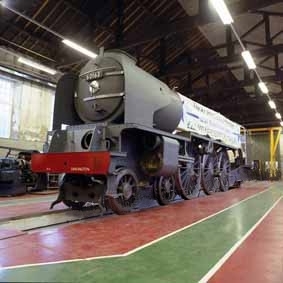
Despite the advent of electric and diesel locomotives in the mid-20th century, steam locomotives continued to be used and constructed into the 21st century. The use of steam locomotives in regular non-tourist revenue service concluded in 2022.
The Great Central Railway (Nottingham) (formerly known as the Nottingham Heritage Railway) is a heritage railway located at the Nottingham Transport Heritage Centre (NTHC), on the south side of the village of Ruddington, in Nottinghamshire. The route consists of almost 10 miles (16 km) of the former Great Central Main Line from Loughborough South Junction (with the Midland Main Line) to Fifty Steps Bridge and the site of Ruddington's former GCR station, plus a branch line from Fifty Steps Bridge to Ruddington Fields station which is located on a former Ministry of Defence site next to Rushcliffe Country Park.

The L&YR Class 31 was a class of 0-8-0 steam locomotives of the Lancashire and Yorkshire Railway. The class was designed by George Hughes and introduced in 1912. The class comprised 115 new locomotives and 40 rebuilt from other classes.
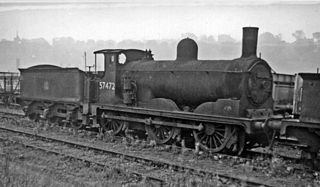
The Caledonian Railway 294 and 711 Classes were 0-6-0 steam locomotives designed by Dugald Drummond for the Caledonian Railway (CR) and introduced in 1883. After Drummond's retirement, construction of the class continued under Smellie, Lambie and McIntosh.
